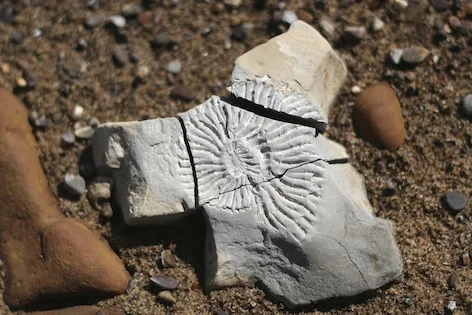Fossils were living animals or plants long long ago.
They were covered up with layers of mud that got hard.
After thousands of years the rock wears away and we see the fossil.
Studying fossils helps us know what Earth was like millions of years ago.
What are fossils?
Fossils tell us about animals that lived on earth in prehistoric times. This is a pterodactylus. Getty Images
Fossils are the remains of a dead animal or plant that has been preserved in rock. They are clues to what things were like a long time ago, before there was a recorded history.
Sometimes the fossil is just an imprint such as a footprint, or even an animal's dung (poo).
Fossils are generally found in rocks that were once under water.
Plants can become fossils ©istock
An animal or plant died and was first covered by mud, and the soft parts decayed, leaving hard material (like bones or shell). Over thousands of years, many layers of soil or mud built up and were squeezed together. Water containing minerals seeped through the layers and changed the plant or animal into rock. Then over more hundreds of years, erosion has worn away the rock and people discover the fossils as they become exposed.
Sometimes a fossil can be similar to an animal alive today, and the differences can tell scientists how that animal has evolved (changed over time)
Fallen trees become fossilised in the same way. Fossilised wood is called petrified wood.
Fossilised insects in amber, which is fossilised tree sap. ©Getty Images
Tree sap that has oozed from a tree can be fossilised into a stone called amber. Sometimes small insects trapped in the sticky sap are inside the amber. This can also show scientists what the first insects looked like.
Palaeontologists
Scientists called palaeontologists (say pale-ee-en-toll-uh-jists) learn about dinosaurs and about what the world was like in prehistoric times by studying fossils.
Palaeontologists gently scraping dirt to uncover a fossil. ©Getty Images
Prehistory refers to a time long before recorded history. There were no people in the time of the dinosaurs, so there was no human recording of what life was like. A study of fossils has given us that information.
Once this fossil bone was uncovered, the palaeontologist uses a brush to uncover it completely. ©Getty Images
Fossil remains of dinosaurs have been found on all continents except Antarctica. Palaeontologists are rather like detectives or puzzle solvers, working out answers from small clues. They piece together small fossils and work out what a prehistoric animal or plant might have been like, using many clues.
Bones are often scattered, and must be gathered and carefully moved to a work area before the work of putting together a skeleton can begin. Fossils are gently freed from the surrounding rock. Dirt is scraped away, and then brushes are used to expose the fossil. It is slow, careful work.
Animal poo gets fossilised too, and is called coprolite. That can tell scientists how big the animal was and what it ate.
Fossilised animal poo is callled coprolite. ©Getty Images
Fossilised animal teeth also tell us what an animal ate: carnivores and herbivores have different teeth, and grooves along the teeth tell scientists whether the animal tore at its prey or swallowed it whole.
Some plesiosaurs had cone-shaped teeth, which were ideal for crushing hard shells of sea creatures like ammonites.
A fossil ammonite ©Getty Images
Claws tell palaeontologists something about how a carnivore caught its prey.
Giant Jigsaws!
When paleantologists have gathered dinosaur bones, it is rather like a giant jigsaw as they slowly piece them together to form a complete skeleton. From this they can begin to solve other questions such as what the animal ate, how it moved and so on, based on the evidence they have discovered. Smaller fossils can also be in pieces that must be put together.
Triceratops skeleton: a giant 3D jigsaw puzzle for scientists ©Getty Images
It's a good idea to get information from more than one source!
Fossilised trilobites ©Getty Images
Read to find out more about fossils and how they form:
http://www.oum.ox.ac.uk/thezone/fossils/intro/form.htm
Read Australian dinosaur fossils:
http://www.alphalink.com.au/~dannj/sites.htm
Read the kidcyber pages:
Dinosaur world: what the Earth was like in that period
Some dinosaurs of the Triassic period
Some dinosaurs of the Jurassic period
dinosaurs of the Cretaceous period
Watch a palaeontologist using fossil clues to work out how dinosaurs made nests
Explore educational games on prehistoric animals at NeoK12










